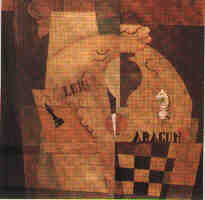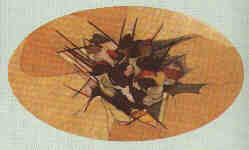 ANNOTATION
ANNOTATIONAn excellent book that deals with these 3 subjects from the perspective of actual projects. It gives a good description of how veneers are produced at a mill. I particularly like the projects that deal with vacuum presses. There is a good article on the marquetry of Vadim Aksyeonov, a Russian artist who creates 'wooden' renderings of Russian landmarks.
Finally there is reference made to the art of marquetry with an extract from the book called Marquetry by Pierre Ramond. There are several examples of his work and some of the students from l'Ecole Boulle which will give you an idea of the scope and range of this medium.
This is a good reference book for the advanced users of veneers particularly in the area of veneer application and the use of woodworking tools.
COVER
Veneering, marquetry and inlay are great ways to dress up your woodworking. In these 23 articles from the pages of Fine Woodworking magazine, you'll get the best technical advice available, with information on everything from sawing your own veneers to creating inlay patterns freehand. There's even advice on working materials like birch bark, silver and turquoise. If you're looking for a way to expand your woodworking repertoire, this collection of articles is a great place to start.
The "Best of Fine Woodworking series spans over ten years of Fine Woodworking magazine. In book form for the first time, the material is organized by subject and indexed for easy reference. There is no duplication between these books and the popular "Fine Woodworking on..." series.
Chances are that veneering, marquetry and inlay aren't the very first things we learn as woodworkers. I know that when I began making furniture, these techniques seemed out of reach. I leaned toward simple pieces made from solid wood. Many woodworkers prefer that style, and choose to stay with it. Others, however, want to add another level of detail to their work. Eventually, they may turn to veneering, marquetry or inlay. All three are essential skills for reproducing some period furniture styles. And as the articles in this book will show you, these techniques can produce remarkable results in contemporary furniture. Veneering, in particular, is one of those techniques you tell yourself you don't need to know only until you've tried it. Then you wonder how you managed without it.
In this collection of 23 articles from Fine Woodworking magazine, you'll get the best technical advice available in the field. Woodworkers will find information on everything from sawing their own veneers to creating inlay patterns freehand. There's even advice on working materials like birch bark, silver and turquoise. In all, the articles are a great place to start for woodworkers looking to expand their repertoire. --Scott Gibson, editor
EXTACTION
The art of marquetry is ancient and dates back to marble incrustations in the palace of King Mausole in 350 B.C. For many centuries after that time, marquetry was centered in Paris, although English and German cabinetmakers were actively decorating furniture with marquetry as well.
In North America, marquetry was not as popular as in Europe. The decoration of 18th-century furniture was taken from the English and Colonial styles, but the shapes and designs were far less elaborate. Much of this early American marquetry was made by a constituent of cabinetmakers in Boston, Mass., who found wood plentiful in this country and worked with sculptors, gilders, turners, upholsterers and lumbermen to cut and prepare veneers.
Between 1788 and 1810, "Early Federal" furniture evolved, influenced by George Hepplewhite's and Thomas Sheraton's styles. The "Later Federal" period (1800-1840) boasted pieces veneered with light-color woods. Since many more European cabinetmakers settled in America during the mid-19th century and onward, some of the more popular European styles, such as Gothic, Rococo, Renaissance and Louis XIV, were very much in fashion in the United States.
In the years between the two World Wars, many cabinetmakers continued working and adopted the Art Deco style. Although the merit of the artistic taste during this period is questionable, the marquetry created was of a very high technical standard. In fact, to cut the very fine grill work that was essential to cloisonne motifs, experience and great manual dexterity were required. Works by Jacques Emile Ruhlmann with their delicate ivory interlacing are proof of such skill. (For more on Ruhlmann's work, see FWW #51, pp. 35-37.)
While the aesthetic quality of the style may be disputed, the artisans were still able to craft superb copies, faithful to the ideals of their predecessors. Since the last century, there has been considerable mechanical progress: The workbench is in its most advanced form and the pedal or electric scroll saw is able to cut a number of veneers simultaneously, producing several copies of a marquetry motif. Many tools, including the small circular saw and trimmer, accelerated the use of marquetry and improved the precision of the arrangements, thereby lowering the cost by increasing the output.
The industrialization of recent years and the progressive disappearance of artisans, however, have discouraged the survival of marquetry. After World War II, furniture was made in mass, and marquetry was not frequently included. It was at this time that marquetry decoration was adapted in "Moustache" style furniture. The furniture made during this period was rectilinear and rather conventional, although it was enriched with beautiful veneer work. Cabinetmakers produced large quantities of furniture that was almost identical, but was covered with a different veneer, that was either dark (Indian rosewood or ebony) or blond (Baltic birch, bird's-eye maple or sycamore the paleness of which was accentuated by applying hydrogen peroxide before varnishing.
Fretwork medallions were incorporated into doors of wardrobes and cupboards and on tabletops and headboards. The main part of this decoration was in speckled, moire, marbled or flamed veneer, arranged simply or with a background effect, such as mosaic squares or circles. The frame was either pierced or fretwork and made from striped veneer of the same tonality, contrasted by a fillet that was 1mm or 2mm wide. This fillet was commonly made from boxwood or sycamore on a darkened-wood ground, or amaranth, ebony, pearwood or hornbeam stained black and inlaid into light furniture.
The elements of character- Wood is the most frequently used material in marquetry. Although a wide assortment of natural-color wood is available, an infinite variety of hues are also possible with dyed wood. Veneer manufacturers classify wood into three categories:
1. Exceptional-figured qualities, which includes walnut, elm, oak, tropical wood, nearly all mahogany, avodire, makore and teak;.
2. Luxury wood, which includes tropical wood that provides veneer that is moire, waved, speckled or flamed, as well as maple, European cherry, tulipwood, kingwood, rosewood, amaranth, satinwood and ebony.
3. Common wood, which is used for plywood and industrial veneer, and includes poplar, beech and most of the species in the other categories if they don't contain any unusual characteristics.
All wood veneers composing a marquetry are selected from exceptional-quality wood, usually from the luxury category.
However, it is not uncommon to see imitations. Plastic laminates with a wood design or geometric composition on reconstituted veneer are easily identified as false marquetry. But new techniques, like transferring, make the expert's task of recognizing a false marquetry piece even more difficult. This method consists in making a genuine motif in wood, which is cut out, and then inlaid by a marqueter. It can be photographed and reproduced, sometimes by the thousands. The photograph, printed on paper or vinyl, is glued onto the piece of furniture, and a coat of polyester or polyurethane varnish eliminates any trace of lamination. Stenciling is another method and involves decorating pieces of furniture with paint that commonly imitates boxwood, ebony, mother of pearl and copper bandings. When the work has been done carefully, stenciling is a fairly good and undetectable method of reproduction.
In recent veers, the increasing use of plastic laminate and the popularity of lacquered furniture have seriously impacted the use of marquetry. Louis XV, Louis XVI and Charles X furniture has been in demand, and the use of marquetry in these pieces has been maintained. A few contemporary artisans have created modern compositions decorated with new and different materials. However, the true marquetry craft is so relatively unknown and the standards of craftsmanship have declined that the decorative possibilities offered by this art form are not fully utilized.
Pierre Ramond is a teacher at l'Ecole Boulle, the University of Paris I and Paris IV and at the Sorbonne, as well as at the French Institute for the Restoration of Works of Art. This article has been adapted with Permission from the new English-version book, Marquetry 1989, which was published jointly by Les Editions H. Vial and The Taunton Press.
Marquetry is the art of painting with wood. Also called intarsia or inlay, it encompasses making pictures and geometric designs with thin slices of colored wood, shell and other precious materials. It is a popular technique for decorating the smooth surfaces of pieces of furniture, as well as a versatile means of creative expression.
 Most furniture made by contemporary designers was rather conventional, although it was enriched with beautiful marquetry. The coffee tables, shown here, represent rather unique, and somewhat abstract, designs. The original ideas and designs are by Luis Ansa, who was inspired by the Cubist School, and the marquetry is by Pierre Ramond. (Photos: Peter Shummer).
Most furniture made by contemporary designers was rather conventional, although it was enriched with beautiful marquetry. The coffee tables, shown here, represent rather unique, and somewhat abstract, designs. The original ideas and designs are by Luis Ansa, who was inspired by the Cubist School, and the marquetry is by Pierre Ramond. (Photos: Peter Shummer).
 The design below is an example of the way some contemporary artisans employ ancient marquetry techniques to make attractive modern compositions. Despite the long tradition of marquetry around the world, today's practitioners contend that the decorative possibilities of the art form have not been exhausted, especially in Light of plastics and other high-tech materials that are now available to marqueters. Made from multiple sheets of sycamore, amaranth, coral and satinwood, this elliptical casket represents an abstract design. It was designed and executed by students of the l'Ecole Boulle, and it is 9 1/2 in. high, 5 1/2 in. wide and 3 3/4 in. deep. (Photo: J.P. Vial).
The design below is an example of the way some contemporary artisans employ ancient marquetry techniques to make attractive modern compositions. Despite the long tradition of marquetry around the world, today's practitioners contend that the decorative possibilities of the art form have not been exhausted, especially in Light of plastics and other high-tech materials that are now available to marqueters. Made from multiple sheets of sycamore, amaranth, coral and satinwood, this elliptical casket represents an abstract design. It was designed and executed by students of the l'Ecole Boulle, and it is 9 1/2 in. high, 5 1/2 in. wide and 3 3/4 in. deep. (Photo: J.P. Vial).
 This fantasy subject, by an L'Ecole Boulle student, is made from barwood, blackened pearwood and blue-dyed sycamore. The flowers are from amaranth, the butterfly from boxwood, the tree from stained bird's-eye maple and the background from flecked sycamore tinted silver-gray. Using dyed veneers enables the marqueter to enrich the overall piece without necessarily increasing the decoration. (Photo: B. Novi).
This fantasy subject, by an L'Ecole Boulle student, is made from barwood, blackened pearwood and blue-dyed sycamore. The flowers are from amaranth, the butterfly from boxwood, the tree from stained bird's-eye maple and the background from flecked sycamore tinted silver-gray. Using dyed veneers enables the marqueter to enrich the overall piece without necessarily increasing the decoration. (Photo: B. Novi).